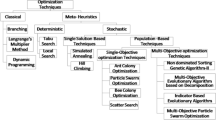Abstract
Most geophysical inversions can be regarded as multiparameter, nonlinear, and multiminimum discontinuous optimization problems. An adaptive hybrid global inversion algorithm based on simulated annealing, downhill simplex method, uniform design, and adaptive annealing rule is formulated. Numeral test and model computation show that this algorithm has very fast speed and high efficiency in searching for global minimum.
Similar content being viewed by others
References
Ingber, L., Genetic algorithms and very fast simulated reannealing: a comparison,Mathl. Comput. Modelling, 1992, 16: 87.
Holland, J. H.,Adaptation in Natural and Artificial Systems, Ann Arbor: University of Michigan Press, 1975.
Kirpatrick, S., Gelatt, C. D., Vecchi, M. P., Optimization by simulated annealing,Science, 1983, 220: 671.
Metropolis, N., Rosenbluth, A., Equations of state calculations by fast computing machines,J. Chem. Phys., 1953, 21: 1087.
Szu, H., Hartley, R., Fast simulated annealing,Phys. Lett. A., 1987, 122(3/4): 157.
Liu Pengcheng, Stephen Hartzell, William Stephenson, Nonlinear multiparameter inversion using a hybrid global search algorithm: applications in reflection seimology,Geophys. J. Int., 1995, 122: 991.
Ji Chen, Yao Zhenxing, The uniform design optimized method for geophysics inversion problem,Acta Geophysica Sinica (in Chinese), 1996, 39: 233.
Liu Pengcheng, Ji Chen, Stephen Hartzell, An improved simulated annealing downhill simplex hybrid global inverse algorithm,Acta Geophysica Sinica (in Chinese), 1995, 38: 199.
Rothman, D. H., Automatic estimation of large residual statics corrections,Geophysics, 1986, 51: 332.
Wang Yuan, Fang Kaitai, On the uniform distribution and the test design number method,Kexue Tonghao (in Chinese), 1981, 26(2): 65.
VanLaarhoven, P. I. M., Aarts, E. H. I.,Simulated Annealing: Theory and Application, Dordrecht: D. Riedel Pub. Co., 1988.
Stork, C., Kusuma, T., Hybrid genetic autostatics: new approach for large-amplitude statics with noisy data,62nd Ann. Int. SEG Meeting, Expanded abstracts, New Orleans, 1992, 1127–1131.
Author information
Authors and Affiliations
Additional information
Project sponsored by the National Natural Science Foundation of China (Grant No. 49474232) and Special Foundation under the auspices of president of Chinese Academy of Sciences.
Rights and permissions
About this article
Cite this article
Ai, Y., Liu, P. & Zheng, T. Adaptive hybrid global inversion algorithm. Sci. China Ser. D-Earth Sci. 41, 137–143 (1998). https://doi.org/10.1007/BF02932432
Received:
Issue Date:
DOI: https://doi.org/10.1007/BF02932432




